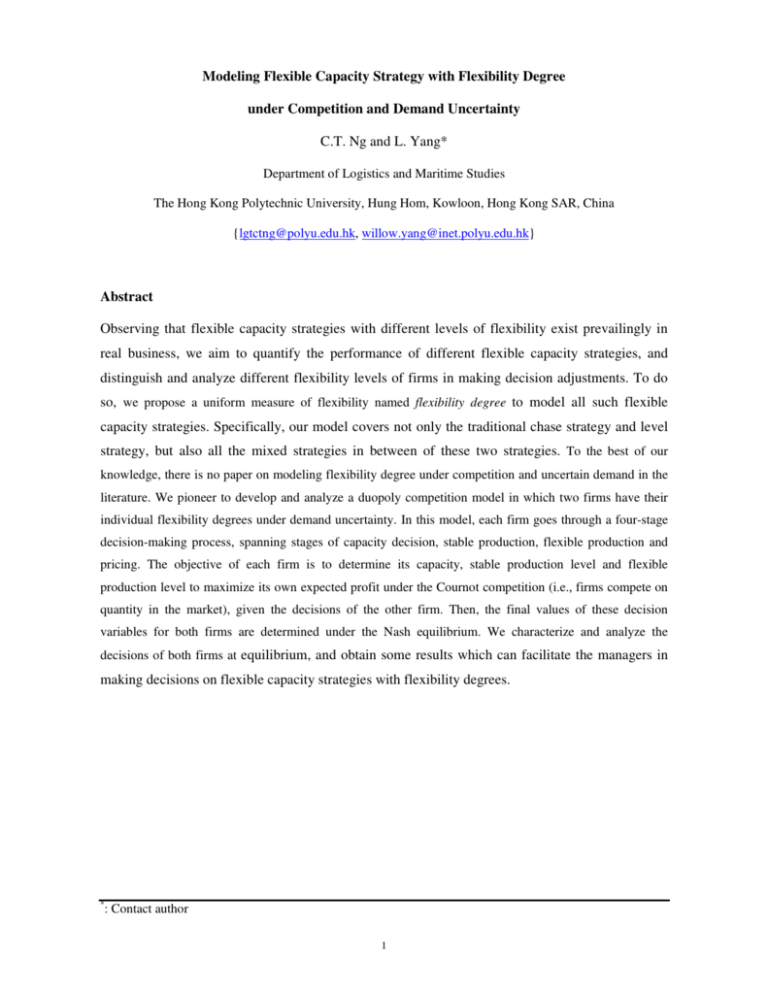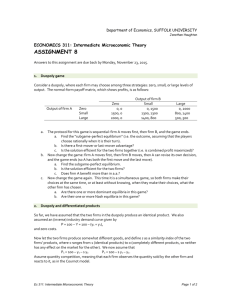
Modeling Flexible Capacity Strategy with Flexibility Degree
under Competition and Demand Uncertainty
C.T. Ng and L. Yang*
Department of Logistics and Maritime Studies
The Hong Kong Polytechnic University, Hung Hom, Kowloon, Hong Kong SAR, China
{lgtctng@polyu.edu.hk, willow.yang@inet.polyu.edu.hk}
Abstract
Observing that flexible capacity strategies with different levels of flexibility exist prevailingly in
real business, we aim to quantify the performance of different flexible capacity strategies, and
distinguish and analyze different flexibility levels of firms in making decision adjustments. To do
so, we propose a uniform measure of flexibility named flexibility degree to model all such flexible
capacity strategies. Specifically, our model covers not only the traditional chase strategy and level
strategy, but also all the mixed strategies in between of these two strategies. To the best of our
knowledge, there is no paper on modeling flexibility degree under competition and uncertain demand in the
literature. We pioneer to develop and analyze a duopoly competition model in which two firms have their
individual flexibility degrees under demand uncertainty. In this model, each firm goes through a four-stage
decision-making process, spanning stages of capacity decision, stable production, flexible production and
pricing. The objective of each firm is to determine its capacity, stable production level and flexible
production level to maximize its own expected profit under the Cournot competition (i.e., firms compete on
quantity in the market), given the decisions of the other firm. Then, the final values of these decision
variables for both firms are determined under the Nash equilibrium. We characterize and analyze the
decisions of both firms at equilibrium, and obtain some results which can facilitate the managers in
making decisions on flexible capacity strategies with flexibility degrees.
*
: Contact author
1
Research Problem
To hedge against demand uncertainty, different capacity strategies are adopted in real business, including
chase strategy, level strategy and mixed strategy. On the one hand, the chase strategy is competitive because
it enables a firm to better match supply to demand by varying its throughput. One successful example is
Dell’s make-to-order strategy (Magretta, 1998). On the other hand, the level strategy is advantageous to
guarantee good quality products and benefit to employees’ loyalty (Colvin, 2009) by keeping a stable
production level. Firms like Toyota and Nissan keep production at uniform levels (Heizer and Render, 2008).
Interestingly, there are more and more firms, if not the most, adopting the mixed strategy, which is in
between of the chase strategy and level strategy. By using the mixed strategy, a firm is able to guarantee a
certain level of production on the one hand, and has flexibility to adjust its throughput to hedge against
demand uncertainty on the other. For example, ABB Motors in Sweden has two types of orders, i.e., maketo-stock (70%) and make-to-order (30%) (Bengtsson and Olhager, 2002). As observed, firms have different
abilities in adjusting their throughputs responding to different demands, which is regarded as volume
flexibility. Firms’ different volume flexibilities are reflected by the extents to which firms can adjust its
production after knowing the actual demand.
In this paper, we aim at providing insights into two issues regarding firms’ flexibility in adjusting their
throughputs. First, we are interested in the impact of a firm’s capability of throughput adjustment on its
operations. Is it possible to quantify and distinguish each strategy? What is a firm’s response to market when
it has a high (or low) ability in flexibility? Answering these questions can shed light on firms’ optimal
capacity strategy and operations under various abilities. Second, we investigate the effects of competition on
decisions of firms with different individual abilities in flexibility. How do we evaluate all the possible
strategies (i.e., abilities in flexibility) in competition? What is the relationship between firms’ strategy
choices and their production decisions in competition? Would two competing firms respond to market in the
same way or in different ways? Should a firm with a higher flexibility invest more in capacity, or just keep
its capacity the same as the rival?
To address these questions, we propose a uniform measure named flexibility degree to distinguish each
strategy in this paper. Under this measure, all strategies are considered as flexible capacity strategy with
different flexibility degrees. We pioneer to develop and analyze a duopoly competition model in which two
firms have their individual flexibility degrees under demand uncertainty. The description of our model and
definition of flexibility degree are given below. Although there are plenty of studies on manufacturing
flexibility in different forms (Van Mieghem, 2003), to the best of our knowledge, there is no paper on
modeling flexibility degree of volume flexibility under competition and uncertain demand in the literature.
In this model, each firm goes through a four-stage decision-making process, spanning stages of capacity
decision, stable production, flexible production and pricing. At the capacity decision stage, each firm
determines its own capacity, with consideration of all the possible decisions of the other firm. At the stable
2
production stage, before knowing the actual demand, each firm produces at a stable production level which
is not affected by the fluctuating demand. At the flexible production stage, after knowing the actual demand,
each firm produces at a flexible production level which is adjustable under its capacity constraint. The total
production of each firm is the sum of its stable production and flexible production, and is bounded above by
its capacity. At the pricing stage, both firms compete on quantity in the market, i.e., Cournot competition.
The objective of each firm is to determine its capacity, stable production level and flexible production level
to maximize its expected profit, given the decisions of the other firm. Then, the final values of these decision
variables for both firms are determined under the Nash equilibrium.
A firm’s total production is adjustable between its stable production level and capacity. This adjustment
range reflects a firm’s ability in varying its throughput. It also reflects the extent to which a firm saves its
capacity to hedge against demand uncertainty. Therefore, flexibility degree is defined as the percentage of
the difference between a firm’s capacity and stable production (unchanged or guaranteed production) over
its capacity, i.e., Flexibility degree =
capacity − stable production
⋅ 100%.
capacity
According to this definition, full flexibility strategy (chase strategy) can be formulated by setting flexibility
degree as 100 percent; while nil flexibility strategy (level strategy) can be formulated by setting flexibility
degree as 0 percent. Any other percentage between 0 and 100 represents a firm’s flexibility capability
between nil flexibility and full flexibility, and so it is able to represent all possible mixed strategies.
Key Methodology and Assumptions
In this model, we adopt a step method to formulate the problem at each stage of a firm, given its decisions in
the previous stages and all the decisions of the other firm. To find the optimal decisions of each firm, we
solve each optimization problem in a backward sequence. Then, we find the Nash equilibrium of the firms in
the competition market.
Specifically, we assume the market clearance rule in the model, i.e., all products are sold in the market and
firms do not hold back to affect the price. To formulate the relationship between the market price and total
production in the market, responsive pricing is adopted and the market price is determined endogenously.
Major Results and Significance
This study fills a research gap to theoretically investigate the mixed strategy. We define and formulate the
flexibility degree, which represents a firm’s ability in adjusting its production level. We further establish a
general formula which is able to quantify and distinguish each strategy. In particular, chase strategy and
level strategy are particular cases with flexibility degrees 100% and 0%, respectively.
Moreover, to investigate the competition effect, we build up a duopoly competition model in which two
firms have their own individual flexibility degrees. In a symmetric competition, where two firms have the
3
same flexibility degree, we solve the problem in Nash equilibrium and show that the two firms make the
same decisions at equilibrium. The individual capacity and expected profit increase with the flexibility
degree. In an asymmetric duopoly model, where two firms have different flexibility degrees, it is found that
the production pattern is very different from that in a monopoly model or a symmetric duopoly model. We
characterize the equilibrium and find the relationship between the firms’ flexibility degrees and their
expected profits. It is found that the firm with a higher flexibility degree invests more in capacity, but
produces less in the stable production stage. In such case, the firm is able to use its flexible capacity as much
as possible. Further, it is shown that the firm with a higher flexibility degree better hedges against demand
uncertainty by its more specific responses to the demand. Specifically, when the demand is within the
adjustment range of the firm with a lower flexibility degree, the two firms respond to the demand in the
same way; and when the demand is beyond this adjustment range, there are still two domains where only the
firm with a higher flexibility degree is able to adjust and achieve its optimal production level to respond to
the demand.
Numerical examples demonstrate that the equilibrium with various flexibility degrees of two firms falls into
a limited closed area. It is also shown that a firm’s optimal capacity at equilibrium is increasing in its own
flexibility degree, while decreasing in its rival’s flexibility degree. However, a firm’s own flexibility degree
has more influence on its decisions than its rival’s flexibility degree. Moreover, the total capacity of the two
firms is increasing in the sum of the two firms’ flexibility degrees.
To sum up, we develop and analyze a duopoly competition model with flexibility degrees and use the results
to explain, or predict, the decision making of the firms. Such understanding will facilitate the managers in
designing their capacity strategies in competition. Future research directions on flexibility degrees may
include, but not limited to, extending our model to oligopoly model, and studying other competition models
with flexibility degrees and other price settings. Thus, our research not only fills a gap in the literature, but
also lays a foundation for future research.
References
1. Bengtsson, J. and J. Olhager, 2002. Valuation of product-mix flexibility using real options. International
Journal of Production Economics, 78, 13-28.
2. Colvin, G., 2009. Layoffs cost more than you think. Fortune, March 30, No. 6, 18.
3. Heizer, J. and B. Render, 2008. Operations Management, Pearson Prentice Hall, Upper Saddle River,
N.J.
4. Magretta, J., 1998. The power of virtual integration: an interview with Dell Computer’s Michael Dell.
Harvard Business Review, 76, March-April, 72-85.
5. Van Mieghem, J. A., 2003. Capacity management, investment, and hedging: review and recent
developments. Manufacturing & Service Operations Management, 5(4), 269-302.
4









